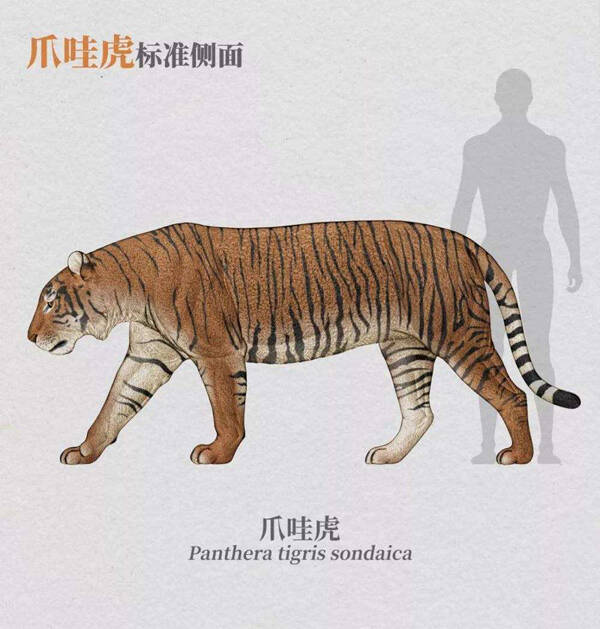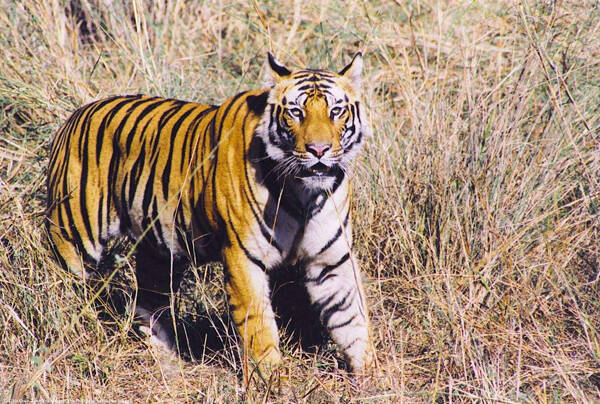Panthera tigris sondaica
IUCN
LCBasic Information
Scientific classification
- name:Panthera tigris sondaica
- Scientific Name:Panthera tigris sondaica,Javan Tiger
- Outline:Carnivora
- Family:Schizopoda Felidae Panthera
Vital signs
- length:2.35-2.55m
- Weight:100-155kg
- lifetime:No verification information
Feature
The most recently extinct tiger
Distribution and Habitat
Javan tigers live in the southern mountain jungles of Java Island. They have excellent vision, hearing and smell. They are not picky about climate conditions. As long as there is a hiding place, water and prey, they are not overly dependent on forests like leopards. Except for the breeding season when male and female Javan tigers move together, they live alone at other times and each needs only 100 square kilometers of activity range.
Appearance
The Javan tiger is about 155 cm long and 80 cm tall at the shoulder. It is a small tropical island tiger and the second smallest tiger. The color of the tiger's fur varies from light yellow to orange-red. Their huge bodies are covered with black or dark brown horizontal stripes, which extend all the way to the chest and abdomen. The fur base color in that area is very light, usually milky white.
The male Javan tiger is 2.35-2.55 meters long and weighs 100-155 kilograms. The female is 2.1-2.3 meters long and weighs 95-115 kilograms.
The Javan tiger has a relatively long nose bone, and the nose tip is usually pink, sometimes with black spots. Its ears are short and semicircular in shape, with black backs and a large obvious white spot in the middle. The tiger's limbs are strong and powerful, with the forelimbs stronger than the hind limbs. Their tails are thick and long, surrounded by black rings, and the tip of the tail is usually black.
The Javan tiger is similar in
Details
The Javan tiger (Panthera tigris sondaica) is a species of tiger that once lived on the island of Java in Indonesia. It has been extinct since the 1980s. Although there are still reports of sightings, none of them have been confirmed. The Javan tiger is the third subspecies of tiger living in Indonesia, in addition to the Bali tiger (also extinct) and the Sumatran tiger (conservation status critically endangered), and is also the most recently extinct species of tiger. The Javan tiger is smaller than the Bengal tiger.

The Javan tiger's most sophisticated attacking weapons are its thick teeth and retractable claws. When hunting, it is extremely ferocious, quick and decisive, and its principle is to consume the least energy to obtain the largest possible harvest. However, when hunting wild beasts, it will never do it if it is not sure enough. .
Javan tigers eat 17-27 kg of meat each time, and large ones can eat up to 35 kg per meal. Because of the thick pads on their feet, tigers move with little noise and are alert and hidden. When they walk on the snow, their hind feet can accurately step on the footprints of their front feet. They have great jumping ability, and each jump is about 5-6 meters away.

In the early 20th century, there were still nearly 10,000 Javan tigers on Java Island. However, in order to obtain their fur and bones, the Dutch colonists and local residents frantically hunted them, causing the number of Javan tigers to rapidly decrease by more than 8,000 in 40 years. In 1945, Indonesia declared independence and established its capital in Jakarta. The population on Java Island soared, leaving Javan tigers, which need a large range of activities, with nowhere to live, and their number decreased day by day. Humans hunted Javan tigers because their fur, bones and meat were extremely valuable. The invasion of Javan tiger habitats by human agricultural production led to a sharp decrease in the number of Javan tigers. In 1988, the Indonesian government was frustrated and helpless and officially announced that the Javan tiger had also become extinct in the 1980s. This was another tiger species that became extinct in Indonesia after the Bali tiger became extinct in 1937.
Protect wild animals and eliminate game.
Maintaining ecological balance is everyone's responsibility!








